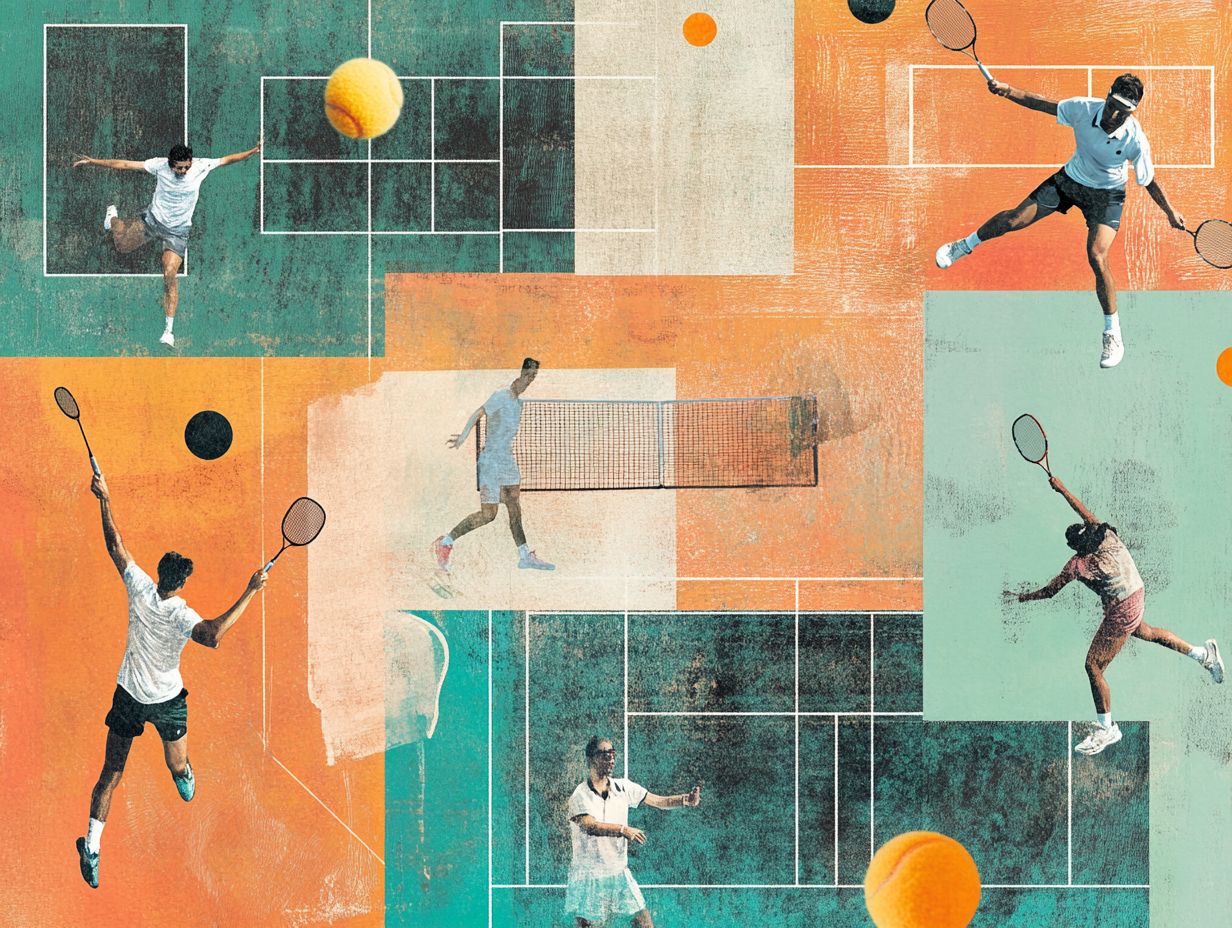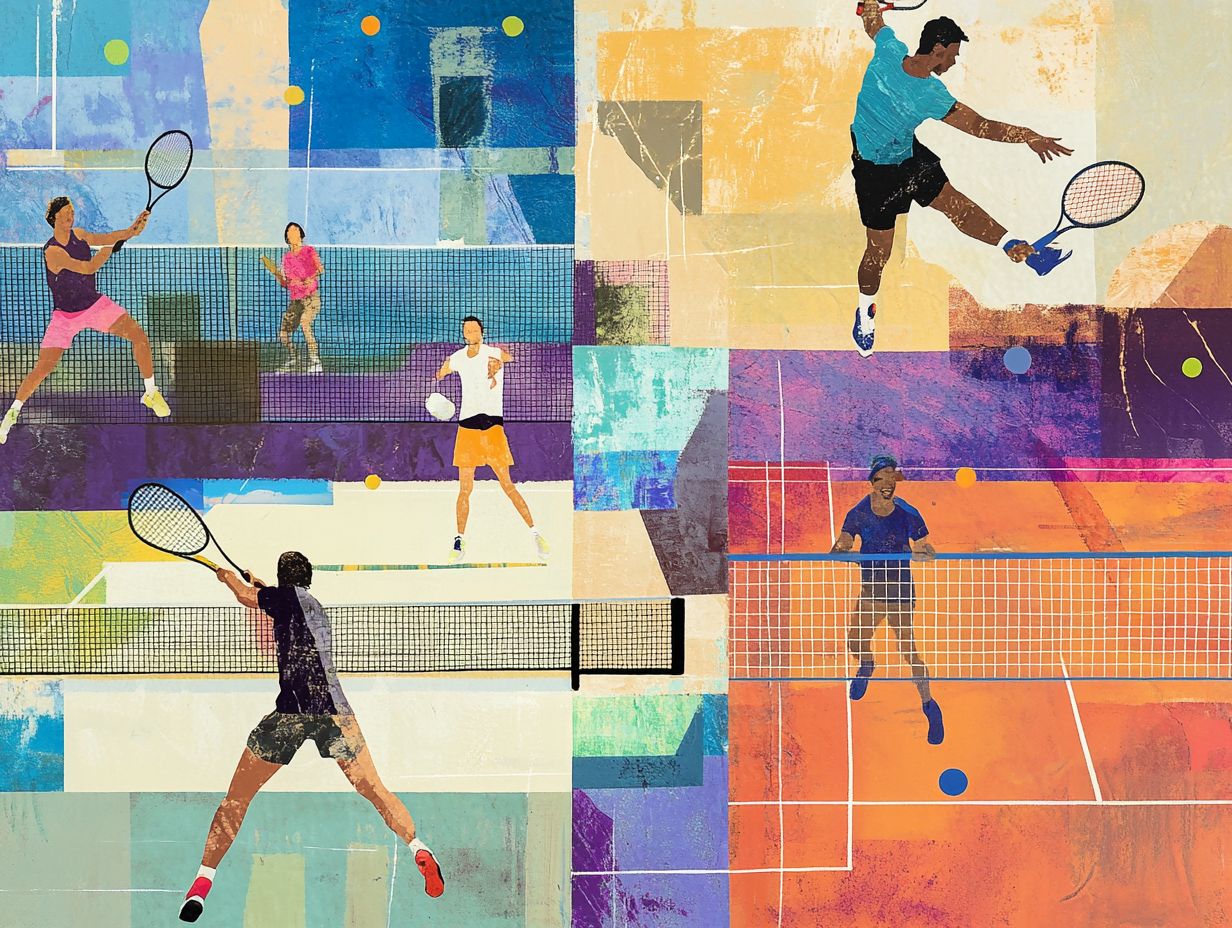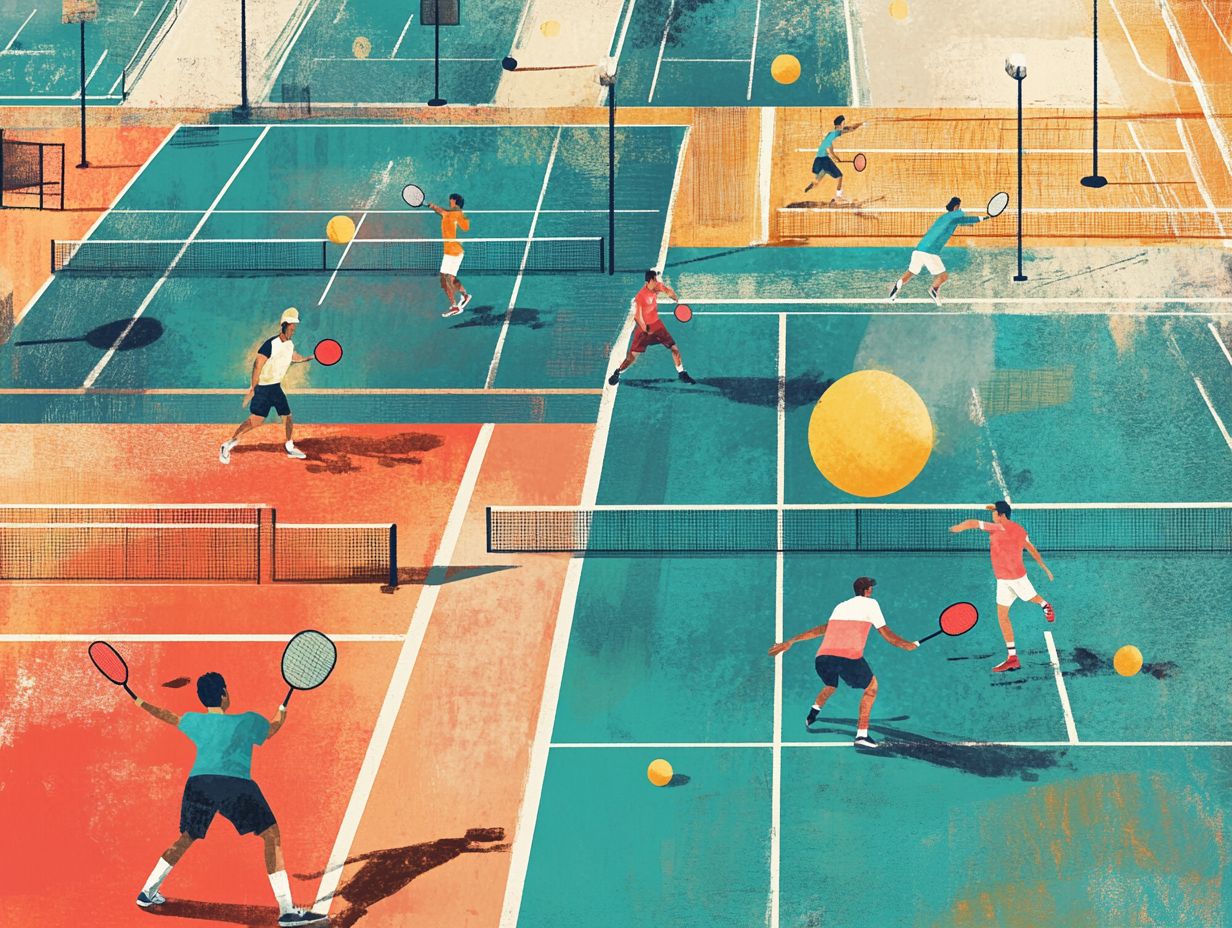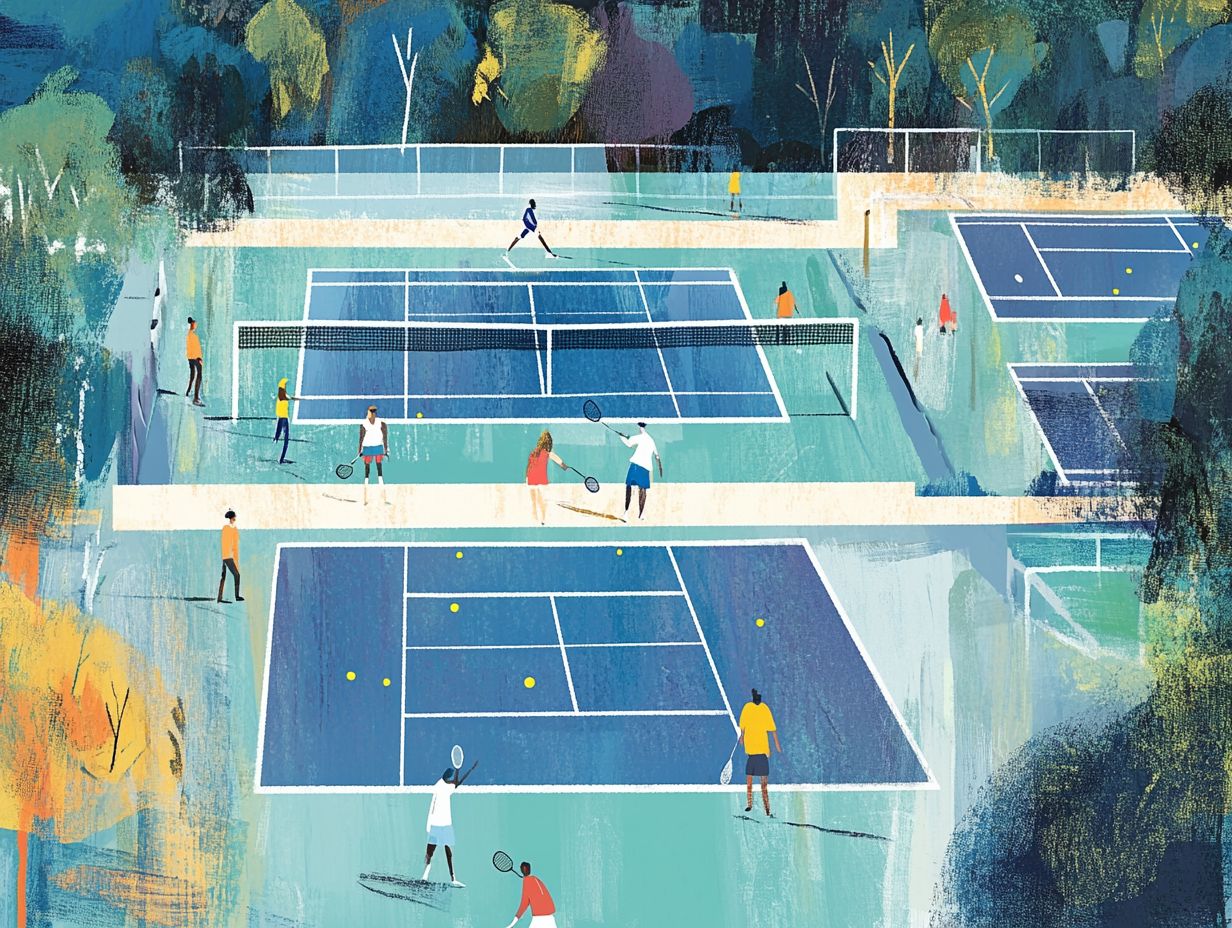Racket sports provide an exciting blend of strategy, skill, and physical activity, with each game featuring unique elements that distinguish it from the others.
This article examines the key differences between tennis, badminton, and pickleball, focusing on their equipment, court setups, rules, and scoring systems.
Additionally, it compares the techniques and fitness benefits associated with each sport, helping you determine which racket sport best aligns with your personal preferences and goals.
Get ready to discover your perfect match!
Overview of Racket Sports

Racket sports like tennis, badminton, and pickleball have gained tremendous popularity worldwide, each offering unique gameplay experiences due to their distinct scoring systems, court dimensions, and specialized equipment, such as racquets and shuttlecocks or balls. These differences enhance player performance and engagement.
Each sport provides its own health benefits and serves as a platform for both competitive and recreational play, fostering social interaction and community involvement through local tournaments and events.
Key Differences Between Tennis, Badminton, and Pickleball
Tennis, badminton, and pickleball are all racket sports; however, they differ in equipment, court size, scoring systems, and styles of play, which all influence player strategy and overall experience.
Equipment and Court Differences
The equipment and court dimensions for tennis, badminton, and pickleball are fundamental aspects that significantly influence gameplay and the overall experience, with notable differences in their specifications.
Each sport features unique elements, including racquets, balls, shuttlecocks, net heights, and court surfaces, which cater to different styles of play.
For instance, tennis courts are larger and designed to accommodate a heavier ball, while badminton courts are smaller and tailored for a lightweight shuttlecock, which in turn affects player movements and on-court strategies.
Conversely, pickleball combines elements from both sports, utilizing a smaller court similar to badminton, yet employing a paddle and a perforated plastic ball that impacts the pace and dynamics of rallies.
The varying net heights across these sports also influence player positioning; tennis emphasizes significant baseline play, whereas badminton encourages rapid transitions from the front to the back of the court.
Players in each sport adopt distinct techniques and footwork, all dictated by their respective playing environments. This underscores how equipment and court characteristics redefine gameplay, tactical approaches, and the overall sporting experience.
Scoring and Rules

Understanding the scoring systems and rules of tennis, badminton, and pickleball is essential for both players and audiences, as these sports share match formats and gameplay regulations that dictate how points are earned and matches are won. The scoring systems vary significantly among these sports, influencing how they are played and competed in.
Tennis Scoring System
Tennis features both traditional and nontraditional scoring systems. The traditional scoring system operates as follows:
-
- 0 points = Love
- 1 point = 15
- 2 points = 30
- 3 points = 40
- 4 points = Game
(provided the player is leading by 2 points)
If the game score reaches 40-40, it results in a deuce. A player must then score two additional points to win the game after reaching deuce. When tied at deuce, players can gain a temporary advantage by winning the next point. If a player scores after achieving an advantage, they win the game.
In 2019, the International Tennis Federation (ITF) approved a new no-ad scoring system for professional tennis. Under this system, players alternate serving points and win the game by reaching 4 points ahead, regardless of whether the score is at deuce. If the score reaches 3-3, players play a deuce point, and the winner of this point is awarded the game.
Additionally, the ITF allows for a tie-break game at the end of a set, where the player who wins does not need to win by 2 points, and only 1 point is added to the winner’s overall score. Amateur tennis also employs a modified version of the traditional scoring system, which uses a point system based on 1, 2, 3, or 7 game points, with players alternating serves. To win a game, players must have a predetermined score higher than their opponent’s score by at least one point. A tie-break is also played at the end of the set to decide the winner.
Badminton Scoring System
Badminton utilizes a rally point system, where a player or team earns a point each time they win a rally, regardless of who served. To win a game, a player or team must reach 21 points and lead by at least 2 points. If the score reaches 20-20, the first player to score 2 points wins.
If the score reaches 29-29, the first player to score 30 points wins the game. A match is won by the player or team that wins 2 out of 3 games. If there is a tie-break at 20-20, the serve alternates between players or teams after every 5 points until one side wins.
Pickleball Scoring System

Pickleball features a unique scoring system. Players earn points only when it is their turn to serve, and they must win by at least 2 points. The scoring system is based on 1, 2, 3, or 7 game points, with players alternating serves. To win a game, a player must reach 11 points; if the score reaches 10-10, the first player to score 12 points wins. When the receiving team wins a rally, players switch positions, and the server serves again. In most amateur and some professional pickleball games, a tie-break game is played at the end of a set. The use of faults and serves in pickleball determines how points are scored.
Common Elements of Scoring
Despite the differences, the nontraditional scoring systems of tennis, badminton, and pickleball share three basic elements: points, games, and sets. A point serves as the unit of scoring; a player earns a point when they serve and either score or their opponent fails to return the ball.
A game then represents the next unit of scoring; the player who earns the first point in a game will win it, provided they maintain a higher score than their opponent by a required margin. Finally, a set is defined as the cumulative scores of all players or teams. The winner of the match is determined by the player or team with the highest cumulative score at the end of play.
Skill and Physical Demands of Each Sport
The skill levels and physical demands of tennis, badminton, and pickleball vary significantly. Players of different skill levels can participate in all three sports, but the differences in skill levels influence the physical requirements of each one.
To excel, players must develop techniques through rigorous training that enhances their endurance, coordination, and footwork, specifically tailored to the unique demands of tennis, badminton, and pickleball. For instance, training for powerful serves in tennis differs from the training needed for quick reflexes in badminton, which, in turn, is distinct from the strategic positioning required in pickleball.
Comparison of Techniques and Strategies

Each sport, whether tennis, badminton, or pickleball, has its own unique set of techniques and strategies that players must learn to maximize their performance. These techniques include serves, volleys, smashes, drop shots, dinks, and groundstrokes, and each sport employs them in a way that creates a distinct style of play. By understanding the strategic implications of each technique, players can adapt their approach based on the challenges presented by their opponents and the specific nature of the sport.
In tennis, the serve is considered one of the most critical skills, as it initiates the point and can influence the outcome of the entire match. Players often combine different serving styles, such as flat, slice, or kick serves, tailored to exploit their opponent’s weaknesses. In badminton, players rely heavily on precise footwork to create opportunities for quick, aggressive plays and deceptive drop shots. Meanwhile, in pickleball, athletes blend power and finesse by utilizing dinks alongside powerful groundstrokes.
By focusing on these specific techniques and their strategic implications within their respective sports, athletes can enhance their performance and gain a competitive advantage over their opponents.
Physical Demands and Fitness Benefits
Playing racket sports such as tennis, badminton, and pickleball presents unique physical demands that offer numerous fitness benefits, ultimately enhancing overall health and wellness. These sports improve cardiovascular fitness, build endurance, and increase mobility by engaging multiple muscle groups through varied movements and gameplay strategies designed to enhance athletic performance.
They require quick lateral movements, powerful swings, and strategic footwork, significantly boosting agility and coordination. Additionally, the social aspect of these sports fosters regular participation and a sense of community, allowing individuals to incorporate enjoyable exercise into their lifestyles and achieve sustainable fitness.
This sustainability enables these sports to provide long-term health benefits, including a reduced risk of chronic diseases, improved mental well-being, and a higher overall quality of life.
Choosing the Right Racket Sport for You
When choosing a racket sport, several factors come into play, including personal interest, fitness goals, age appropriateness, and skill level.
Each sport presents unique opportunities for participation in both recreational and competitive play.
Factors to Consider
When choosing a racket sport, it is essential to consider factors such as age, skill level, equipment costs, and the time required to learn the game, as these aspects can significantly influence both enjoyment and accessibility.
Racket sports cater to a diverse range of players, so selecting one that aligns with your physical abilities and personal preferences is crucial for ensuring a satisfying experience.
The social dimension of the sport can also enhance enjoyment; for instance, tennis often attracts players of varying ages who enjoy playing doubles together, fostering a sense of community. Conversely, badminton may appeal to those seeking a fast-paced and entertaining activity for casual gatherings with friends or family.
Access to courts and facilities is another important consideration, as different sports have varying requirements that can affect participation levels.
Additionally, understanding your fitness goals—whether competitive or recreational—can help you choose a racket sport that fits your lifestyle and encourages long-term commitment and enjoyment.
Personal Preferences and Goals
Identifying personal preferences and goals is crucial when selecting a racket sport that aligns with one’s expectations for competitive or recreational play, as well as socializing and community involvement. Whether someone aspires to compete in local, national, or international tournaments or prefers playing casual matches with friends, understanding these goals will help ensure that the chosen sport meets their needs.
Engaging in a racket sport can significantly enhance one’s lifestyle by offering a healthy blend of physical activity and social interaction. Joining local clubs or community groups allows individuals to connect with others who share similar aspirations, creating an environment that is not only competitive but also fosters enjoyable friendships.
Participating in organized competitions and training provides opportunities to acquire new skills and build important social connections. Therefore, aligning personal preferences and goals with the right sport cultivates an atmosphere that promotes both personal growth and community togetherness, ensuring that time spent in racket sports is enjoyable.

Pickleball’s more than a game to me—it’s a passion. I write, sharing its highs and lows, the thrills and the lessons. Some tales might draw you to the court, while others give a hint of the game’s magic. So, curious about my journey? Ready to dive deep into the world of pickleball with me? Let’s go.
